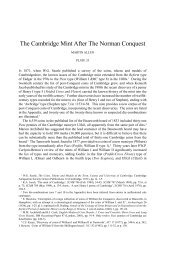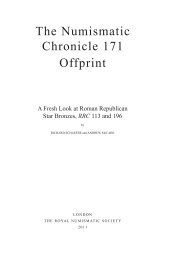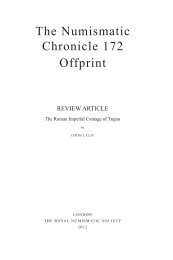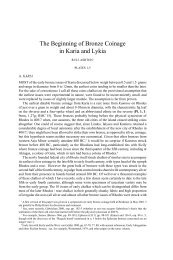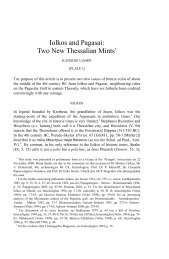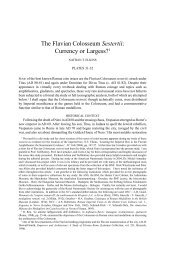The Numismatic Chronicle 171 Offprint - Royal Numismatic Society
The Numismatic Chronicle 171 Offprint - Royal Numismatic Society
The Numismatic Chronicle 171 Offprint - Royal Numismatic Society
You also want an ePaper? Increase the reach of your titles
YUMPU automatically turns print PDFs into web optimized ePapers that Google loves.
THE CONFUCIAN MESSAGE ON VIETNAMESE COINS 377<br />
reversed, also appears in the afterword of the Shiji: ‘the people are well provided for,<br />
families have suffi cient’ (ren ji jia zu 人給家足). 64<br />
10. 川至山增 Xuyên chí sơn tăng<br />
Ch. Chuan zhi shan zeng // Rivers fl ow, mountains rise.<br />
Inscription found on coins of the Minh Mạng, 65 Thiệu Trị 66 and Tự Đức 67 eras.<br />
<strong>The</strong>se four characters are from the poem Tianbao 天保 in the Shijing. 68 This poem<br />
was used in various abbreviated forms for numerous inscriptions on coins in this<br />
series (see also type 37).<br />
2. <strong>The</strong> four-character moral maxims on coins of the Thiệu Trị era<br />
11. 天下大同 Thiên hạ đại đồng<br />
Ch. Tian xia da tong // Universal harmony throughout the empire.<br />
Inscription found on coins of the Thiệu Trị69 era. <strong>The</strong> reverse illustrated by Schroeder<br />
(no. 161, Fig. 1) and attributed to Minh Mạng is not genuine.<br />
‘Universal harmony’ (Ch. Da tong) results from good government in which virtue<br />
overwhelms any bad elements of society. <strong>The</strong> chapter Li yun in the Liji (Book of<br />
Rites) says: ‘Thus, plots will be blocked and cannot be developed. Robbers, brigands<br />
and rebels will not be able to do anything. For this reason the external gates will not<br />
shut. This is what is meant by universal harmony’ (shi gu mou bi er bu xing, dao qie<br />
luan zei er bu zuo, gu wai hu er bu bi, shi wei da tong 是故謀閉而不興,盜竊亂賊<br />
而不作,故外戶而不閉,是謂大同). 70<br />
12. 萬世永賴 Vạn thế vĩnh lại<br />
Ch. Wan shi yong lai // Ten thousand generations will reap the results.<br />
Inscription found on coins of the Thiệu Trị 71 and Tự Đức 72 eras. <strong>The</strong> reverse illustrated<br />
by Schroeder (no. 162, Fig. 2) and attributed to the Minh Mạng era is a coin of the<br />
Thiệu Trị era.<br />
(Yushi dafu 御史大夫). He insisted on the necessity to reduce the unnecessary expenses of the court,<br />
the importance that one should give to agriculture and the indispensable promotion of the study of<br />
Confucian works. Furthermore, he proposed a suppression of coins and a return to barter as a means of<br />
exchange (Hanshu, LXXII, pp. 3075–6).<br />
64 Shiji, CXXX, p. 3291.<br />
65 Schroeder, Annam. Etudes numismatiques, no. 160; AS, III, p. 15; CMV, no. 1526; Barker, Historical<br />
cash coins of Viêt Nam, no. 167.<br />
66 Barker, Historical cash coins of Viêt Nam, no. 182.<br />
67 Lacroix, Numismatique annamite, no. 463.<br />
68 Shijing, Xiaoya-I-6, p. 183.<br />
69 Barker, Historical cash coins of Viêt Nam, no. 183.<br />
70 Liji, IX, p. 368.<br />
71 Lacroix, Numismatique annamite, no. 450; CMVS, no. 424; Barker, Historical cash coins of Viêt<br />
Nam, no. 185.<br />
72 CMV, no. 1785.



